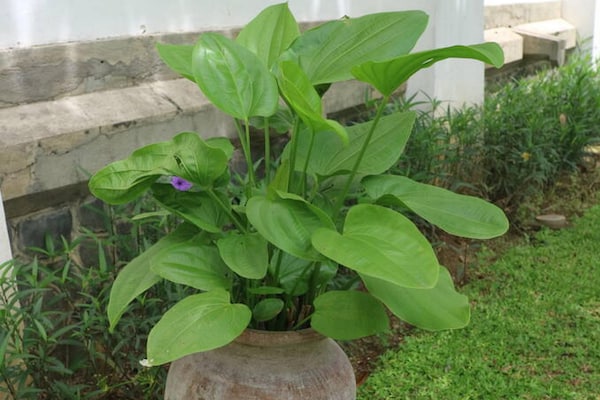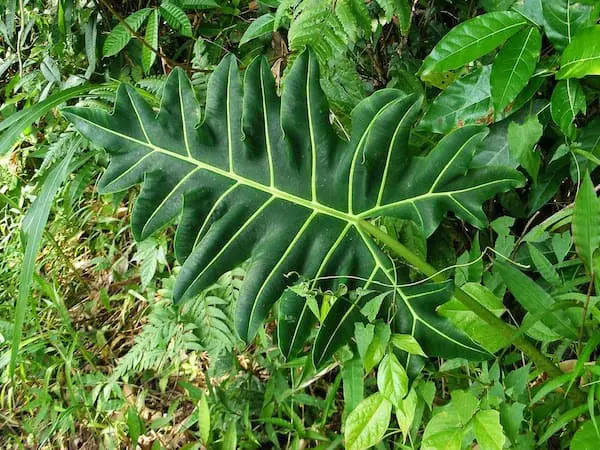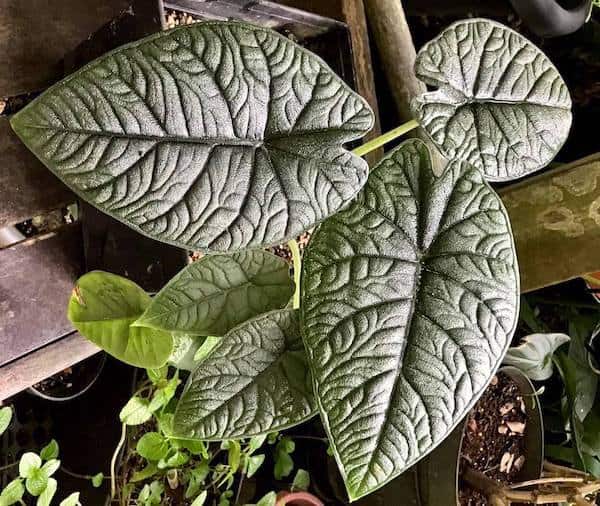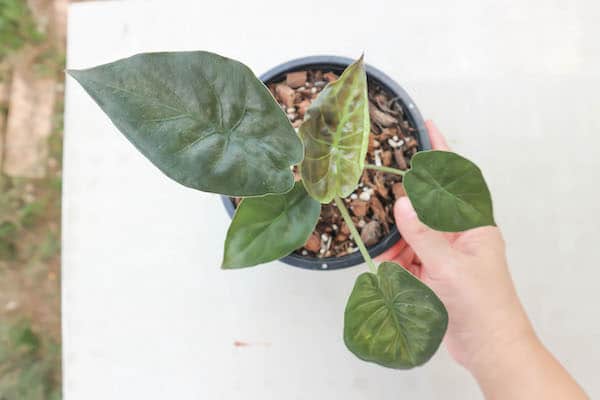The stunning tropical Alocasia species is well known for its beautiful foliage. Also referred to as the “African Mask”, or “Elephant Ear” due to its leaves, this tropical plant species is a houseplant favorite.
They are native to the tropical and subtropical regions of Asia, the Philippines, the South Pacific Islands, and eastern parts of Australia.
Its dramatic appearance will furnish your home or office space with a taste of the jungle thanks to the gigantic glossy green foliage. Alocasia plants have glossy leaves with white and green veins.
Generally, only a few types of this plant are well known, but the numerous cultivars merit consideration.
How Many Alocasia Varieties Are There?
Alocasia varieties are a tuberous or rhizomatous broadleaf plant genus that is a member of the Araceae family. It is a perennial, flowering plant that boasts more than 97 accepted species.
There are actually many more types of this ornamental plant counting the hybrids and cultivars. Hybrid versions are often created for a specific form of leaves, color, or size.
There are also compact varieties that work in smaller spaces, while some versions of this plant can reach an impressive 12 feet tall and five feet wide. The Alocasia leaf sizes make them ideal for large open spaces and lobbies.
Popular Types of Alocasias
1. Alocasia amazonica “Polly”
The Alocasia Polly cultivar is one of the most well-known and popular alocasia plants. It is often referred to as the Kris plant or African Mask plant. It is characterized by dark green leaves featuring prominent white veins and wavy edges.
This is a hybrid first bred in the 1950s by a nursery owner, Salvatore Mauro, from the Alocasia Sanderiana and the Alocasia Watsonian.
2. Alocasia baginda “Silver Dragon”
Unique, exquisite foliage characterizes this stunning Alocasia cultivar, also known as the Alocasia Dragon Scales. Leaves are a pale bluish tint and silvery, hence the name. Its prominent veins vary in color from deep to sage green.
The Alocasia Silver Dragon is a smaller plant variety that will generally grow to three feet in width and height. Its leaves rarely measure more than six inches long.
3. Alocasia cucullata “Hooded Dwarf”

Smaller than other Alocasia varieties, the Alocasia Hooded Dwarf variety is also referred to as “Buddha’s Hand.” This particular Alocasia plant is often found in Buddhist temples in countries like Laos and Thailand. It is considered a good luck plant, bringing fortune to its owner.
Leaves are emerald green with a glossy surface and prominent veining on the foliage’s underside. Leaf edges are upturned and wavy.
This plant will grow no wider or taller than three feet with its leaves reaching a maximum of 12 inches in length.
4. Alocasia cuprea “Red Secret”
With striking reddish and pinkish-hued leaves, the Alocasia Red Secret grabs attention for its unusual coloring. Leaves will emerge as copper-colored green babies with a pink hue to them.
As they mature, its textured leaves develop into a darker green, but still retain the pink shimmer. The veins are dark to the point that they appear black.
This Alocasia will grow to three feet in both width and height, with foliage reaching an impressive twelve to eighteen inches long.
5. Alocasia infernalis “Black Magic”
With black-purplish leaves and a metallic surface, in certain lighting, the leaves of the Alocasia Black Magic actually shimmer with a red hue.
This is an exotic, glamorous plant that will grow to about 15 inches tall. Leaves may grow as much as six inches long. It is a conversation piece in any décor.
6. Alocasia lauterbachiana “Purple Sword”
The Alocasia Purple Sword has long, narrow leaves with scalloped edges, resembling s a sword and thus the name for this striking alocasia cultivar. The leaf tops are a lovely medium green, while the leaf undersides boast a unique purple color with a hint of copper.
This cultivar can reach a height and width of four feet. The foliage tends to be longer than most other varieties, growing to two feet long with a width of only two inches.
7. Alocasia longiloba
The Alocasia longiloba is easily identifiable for its narrow leaves that are shaped like shields. The leaf tops are a blue-green shade, while the undersides are a dramatic deep purple tint.
The primary veins are large and silvery-white. While leaves are large and long, measuring three feet in length and a foot to fifteen inches in width, the height of these cultivars will not surpass three feet.
8. Alocasia macrorrhizos “Giant Taro”
The Alocasia Giant Taro has shiny, large, green arrow-shaped leaves that distinguish this alocasia type from other cultivars. You will need space to host this plant.
This is one of the larger cultivars of the Jewel Alocasias growing to an extraordinary six feet tall and up to five feet wide. Wavy, veined, foliage can grow to three feet in length, explaining why it’s called “Giant.”
This plant is often cultivated as food and stems can be cooked for consumption or can be used to create starch.
9. Alocasia macrorrhiza “Stingray”
The Alocasia Stingray and the Baby Ray are unique and share the zebra pattern of the Alocasia zebrina, however, the shape of the foliage is entirely different.
The Alocasia Stingray leaves are round-shaped, ribbed, and point outward and upward. The distinguishing feature is the whip-like tail growing at the end of each leaf that resembles the wings and tail of a stingray.
The Stingrays can grow to be three to five feet tall. The Baby Ray version will not exceed three feet tall.
10. Alocasia maharani “Grey Dragon”
The Alocasia Grey Dragon resembles its parent plants as this cultivar is a hybrid of the Alocasia reginula and the Alocasia rugosa Melo. It is an extremely rare Alocasia and is characterized by muted deep green silvery leaves.
Despite the Alocasia Melo being one of its parent plants, the Grey Dragon is a bit of a dwarf as it will rarely grow more than 14 inches tall. Leaves can grow up to 6 inches long.
11. Alocasia odora variegate
The Alocasia odora’s large, heart-shaped leaves with a bright camouflage design make this particular cultivar stand out in the crowd.
Leaves feature pale green and white splotches, specks, and patches and each leaf boasts a unique design with no two patterns identical. Some leaves may grow as solid colors of either white or green, giving this plant a truly unusual appearance.
The odora variegate can grow to heights of four feet with leaves reaching sixteen inches long.
12. Alocasia plumbae “Flying Squid”
No Alocasia foliage is narrower than that of the Alocasia Flying Squid. This alocasia cultivar actually looks like a relative of an air plant or a stunted version of a Ponytail palm with its wild curved petioles.
The shape and direction of this foliage resembles a squid. At the end of these curling petioles, a tiny, pointed leaf emerges from a maroon-colored tubular stalk.
13. Alocasia portei

Popularly called the Malaysian Monster, this alocasia is a showstopper because its foliage resembles arugula and giant arugula. Monster it is indeed in size, being one of the larger plants in the alocasia family.
The Alocasia portei grows up to eight feet tall with foliage that spans four feet. Leaves are lobed for a truly unusual appearance.
14. Alocasia renigula “Black Velvet”

The Alocasia Black Velvet is one of the smallest alocasia varieties. Its leaves feature a great velvety texture and this plant will reach a foot tall at most. They will grow multiple stems.
This alocasia has been grown successfully indoors by many growers around the world. It can be used as a houseplant for small spaces and apartments, or planted outside in a container.
15. Alocasia rugosa “Melo”

The Alocasia Melo boasts thick foliage featuring a deeply ridged design. Its leaves are jade green with a hint of blue. Its rough surface texture highlights the intricacy of the plant’s veins.
This alocasia appears more like a garden shrub and can grow to two feet tall with enormous leaves that expand to 20 inches long and 10 inches wide.
This is a small alocasia variety, so expect it to max out at about a foot. It also has a shorter lifespan than other cultivars.
16. Alocasia Sanderiana
The Alocasia Sanderiana or Sander’s Alocasia is also named the Kris plant. It has shiny leaves in an arrow shape with a dark deep green hue that makes them look like black leaves.
Veins are large and whitish or yellowish in hue, and the ruffled edges of the leaves are like wavy blades. The undersides of the leaves are purple to reddish.
This alocasia cultivar will grow to approximately two feet tall with leaves that can reach sixteen inches in length and eight inches in width. The sanderiana will produce red-orange berries that are not edible.
17. Alocasia wentii

Recognized by its large deep green leaves with bronze-purplish undersides, the Alocasia wentii features a leaf shape that resembles an elongated heart.
These plants can grow to four feet in height with leaves can reach a remarkable three feet long. Another unique quality is the “drip tips” on the leaves that allow water to slide off its leaves.
18. Alocasia zebrina “Reticuata”
A cultivar of the Alocasia zebrina, this plant also has distinctive yellow and black markings on its petioles that resemble a zebra print design.
The foliage boasts a singular interlacing net-like pattern known as reticulation that is special only to this plant type. It is an impressive plant growing three feet in both width and height.
19. Alocasia Xanthosoma “Mickey Mouse”
The Alocasia Mickey Mouse is a rare elephant ear variety with light-green and cream variegation on its dark green leaves. It grows up to six feet tall with leaves that measure up to twenty inches in length and ten inches in width.
Its Mickey Mouse name comes from its round leaves that look like the famous Mickey Mouse.
Buy it at FastGrowingTrees.com.
Best Types of Alocasias
When attempting to determine the best type of plants for you, much will depend on:
- Your personal taste
- The amount of time you have to care for your plant
- Where you plan to place it at home
- Your home décor.
Any of the Alocasia cultivars on this list are worthy of consideration and there is a wide variety to choose among.
There is no overall “best” type of alocasia, however, if you are looking for an easy-to-care-for cultivar, the Alocasia Polly is one of the easiest to grow indoors.
If you are looking for a small plant, the Alocasia Black Velvet is a good option, even fitting in a terrarium. If you want a larger plant, the Alocasia Giant Taro is quite impressive.
For a more unique plant, an Alocasia Stingray is perfect.
Whichever alocasia you select, you’ll enjoy growing it at home or the office.
General Alocasia Plant Overview
Alocasia Foliage
At the end of a petiole or stem, the Alocasia’s greatly admired leaves emerge and are able to grow three to five feet long. Stems grow from the plant’s base. Foliage can grow to point upward or downward depending on the species.
Alocasia Roots
Alocasia grows from rhizomes that are stems that grow underneath the soil surface in a horizontal direction.
As they have nodes, new roots will sprout from these nodes down into the soil bed while new stems will shoot upward and emerge from the surface.
This is a method for the plant to reproduce. A piece of rhizome left in the soil can become a new plant.
Alocasia Growth
These plants are characterized by a particular growth pattern that is vertical. Each new plant cluster will grow vertically higher than the previous one.
They do not grow horizontally, distinguishing them from many other tropical species.
Alocasia Availability
Garden centers and nurseries will sell smaller cultivars that are more appropriate as houseplants. This includes the jewel Alocasia subgroup that features rainforest exemplars with unusual or unique shapes, textures, and foliage color variegation.
Types of Alocasias Final Thoughts
The Alocasia, whether grown indoors as a houseplant or outside in a garden, boasts some of the most striking and dramatic foliage among tropical plants.
Its popularity has increased, especially as a houseplant above all because of its sculptural form and visual appeal.
An Alocasia makes a statement in any location and will be a showstopping conversation piece regardless of where you place it, as long as it has plenty of bright indirect light.
If you have adequate space for a large species, it will dominate the space with beauty and elegance. Any location or space’s decor will be improved by hosting this superb plant.















